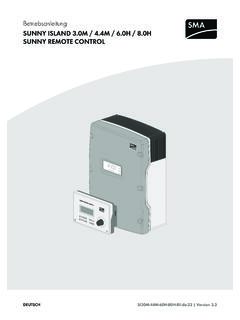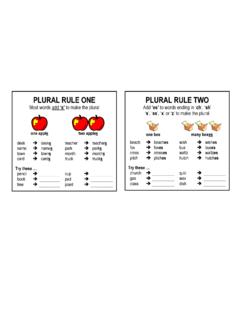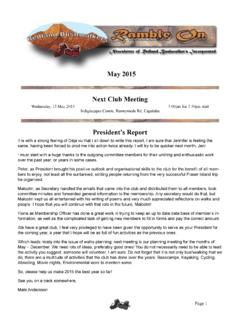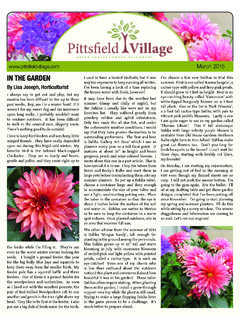Transcription of SUGGESTED PROCEDURE FOR INSTALLATION OF …
1 SUGGESTED PROCEDURE . FOR. INSTALLATION OF. PRECAST CONCRETE BOX CULVERT. SUGGESTED PROCEDURE FOR. INSTALLATION OF. PRECAST CONCRETE BOX CULVERT. TABLE OF CONTENTS. Introduction .. 1. Delivery 1. Scheduling 1. Unloading and Placing . 1. Sequence ..2. Site 2. Water 2. Grade 2. Bedding 2. Alignment 3. Setting .. 3. Joint Sealant . 3. Joining .. 4. Completion .. 5. Common Problems ..5. Appendix ..i Bedding Configuration ii Joint Sealant Detail . iii Joining PROCEDURE iv SUGGESTED PROCEDURE FOR. INSTALLATION OF. PRECAST CONCRETE BOX CULVERT. INTRODUCTION. This paper presents a SUGGESTED PROCEDURE for the proper INSTALLATION of precast concrete box culvert. It is simply a guide. PROCEDURE -wise, it is not all-inclusive and is not intended to supersede project specifications. Federal regulations covering safety for all types of construction, including sewer and culvert installations, are published in the Safety and Health Regulations for Construction under the Department of Labor, Occupational Safety and Health Administration (OSHA).
2 By way of precaution, the precast concrete box culvert installer should be familiar and compliant with the pertinent sections and regulations of this document. The installer should also review INSTALLATION practices with the engineer's design assumptions, particularly in relation to the use of trench boxes, foundation preparation, joint gap allowances, and compaction requirements of the backfill. DELIVERY. Scheduling The contractor should know the weight of each box section, the number of sections to be hauled on each load, what joint sealant and/or wrap material is to be used and delivery schedule of that material. Boxes 10' x 8' and larger require lo-boy trailers which may require advance scheduling. Unloading and Placing The unloading equipment should have adequate capacity to handle the weight of the box and the necessary mobility to lift and set it down with the lifting assembly. A crawler or truck crane or back hoe of sufficient size must be available.
3 Where possible, a site for unit storage or stringing should be provided. When direct placement from truck trailer to final location is required, a crane with stabilizers should be used. Crawlers without outriggers, or backhoes may not have the stability or accurate movement necessary to line up the box units for proper INSTALLATION . Generally, precast box sections are provided with four (4) Conac 10T DR lifters evenly spaced in the top slab. Appropriate capacity multi- leg cable sling with clevis's are to be supplied by the installer of the box culvert sections. The manufacture has the Conac lifting fixtures available for purchase to attach to the lifters and cables and upon return of the fixtures in good condition; the purchase price will be refunded. Cable companies can provide assistance in designing rigging for lifting of boxes. -1- Sequence Standard and special box sections (bends, shorts, bevels, ect.) are generally installed following a lay schedule.
4 The units should be shipped in order of placement from downstream to upstream, unless otherwise advised. Place the bell (groove) of the box upstream. Unloading should take 5-10 minutes for each unit depending on job conditions. The unloading to placement should take 30-50 minutes if no problems are encountered. SITE PREPARATION. Water Control of surface and subsurface water is required so that dry conditions will be provided during excavation and box laying. Ground water conditions should be investigated before they are encountered during the course of excavation. If the water table is in the trench zone, appropriate dewatering methods must be employed. The engineer must consider the effects of future water table levels as it applies to the backfill material around the precast concrete box as well as the box construction itself. Migration of bedding and backfill material should be prevented. Grade Box Culverts provide a broad surface on the bedding and, therefore, normally do not settle, nor can they be forced down to grade.
5 It is important to have a good level grade established prior to box placement. Base material should be fine to medium granular material. Coarse materials are harder to fine grade. The boxes should be aligned accurately prior to pulling home. A small transverse trench (shovel width wide x depth of granular material x width of box) should be formed at the end of the last installed box section to allow granular material to fall into when the next box section is pulled into place. Experience suggests it also helps to hold the grade slightly low as the bedding has a tendency to rise during the box joining process. Box sections placed on drop walls or wing wall footings can be accomplished if final inlet footing is appropriate to allow for deviations in line, grade, box length, and joint variations. With care, footing excavation and INSTALLATION can normally be accomplished after the box is in place. Normal creep in the line will be to 1-inch per joint.
6 Allow for joint length (4-1/2 inches) when necessary. Bedding As indicated in the sketch titled Bedding Configuration for Reinforced Concrete Box Culvert shown in the Appendix, the minimum thickness of the bedding material is 6- inches or in accordance with the project specifications if greater. The bedding, comprised of medium granular material, should be constructed to provide uniform support for the full length and width of each section. This may be accomplished by placing on top of the base material, a 2-inch minimum thickness leveling course consisting of fine granular material graded as required. -2- Where unstable material is encountered below the plan foundation, it should be removed to the depth and width directed by the engineer and replaced with granular material. Rock/boulders encountered at the box bed must be removed at least six inches below the bottom of the box section and replaced with granular material. The final grade for the bedding should be established by using a laser (or level) and grade stakes placed as often as necessary.
7 Final grading should be accomplished by screeding the granular material. The screed board should be as long as the width of the outside span of the box (span + 2 x the wall thickness). Attach a 4-foot level to the top of the screed board. Starting at the downstream end, workers should screed the granular material, filling in low spots and leveling off high spots. Special attention to the final grading will speed the setting of the box culvert sections. ALIGNMENT. INSTALLATION of the first few box sections should be done with special care as it will influence the line and grade of the system to follow. Line and grade can best be controlled with a laser instrument set on a solid surface in or out of the box section. Set on line using the internal centerline at the invert of the box section, and set on the desired grade, the laser provides a constant reference line from which measurements can be taken at any point along the beam. Again, INSTALLATION of the first box is critical to establish proper alignment of the box sections.
8 A little extra time setting the first box will save a great deal of time throughout the remainder of the INSTALLATION . SETTING. Joint Sealant A flexible butyl blend material packaged in 1 to 2-square inches x 10-ft paper wrapped rolls is commonly used as a joint sealant for box culverts. (See sketch titled, Joint Sealant Detail in the Appendix). Place the joint material on the bottom half of the groove (bell) of the box last placed. Place the balance of the joint material on the top half of the tongue (spigot) of the box to be set. The material should be placed about 1-inch from the leading edge of the groove and tongue. In cold weather it may be necessary to heat the joint material prior to application. Storing joint material in a sunny location will allow heat absorption and make the material more workable. When installing filter fabric or an external wrap at joints, slip the material under the box joint prior to setting the box in place, or position just prior to pulling the box home.
9 Roll excess material, to be used for the sides and top, up in bundles on each side of the box. When the box is in the home position finish the joint wrap INSTALLATION . It is desirable to place external joint wrap in one continuous strip. If short strips are used, the joint wrap -3- across the top slab joint should be continuous and extend 12-inches down the vertical sides, overlapping the vertical side wall strips. Joining Remove the granular material 6-inches in front of the groove of the previously set box to a depth of about 3-inches. This prevents the granular material from moving into the joint as the boxes are pulled together. Pick up the box to be placed and line up as close as possible with the box in place and start the joining process. Take care so the joint material does not contact before the joint is started. This may cause the joint material to loosen and sag. Hold the box in this position and hook up the tugging device(s) to the pulling assembly.
10 The person giving crane directions should be positioned on top of the box section previously set. This person should be able to clearly see the crane operator. When joining box sections together, chains or winches should be used. Construction equipment such as backhoes, front end loaders, etc, must not have direct contact with the precast box sections. Using such equipment to push the box sections together can cause point loading which can damage the box(es). Bring the box section to be installed to rest on grade about 18 to 30-inches from the box in place. Check joint alignment and make the adjustment on the lifting device as necessary. Clean joints and complete INSTALLATION of joint sealant material if not previously performed. Direct the crane operator to bring the tongue end of the box to a position in front of the receiving groove. Bring the top slab of the box about 2-feet above the top slab of the box previously set. Looking down the vertical face of the tongue and the grove, direct the crane operator to move the box sideways until the tongue is lined up with the receiving groove.




